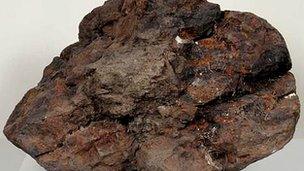UK's 'biggest' meteorite to go on display in Salisbury
- Published

The meteorite is thought to have landed on earth 30,000 years ago
A meteorite which was discovered in Wiltshire and is considered to be the biggest to have fallen in the UK, is to go on display in Salisbury.
The 200lb (90kg) meteorite is thought to have been found in the 19th Century by Edward Duke, a previous owner of Lake House in Wilsford-cum-Lake.
Experts say the 1.6ft (0.5m) long rock landed on earth about 30,000 years ago.
The Salisbury and South Wiltshire Museum is to display the meteorite for two weeks from Monday.
Experts believe the meteorite, known as a common chondrite, was preserved by the frozen conditions during the last ice age.
Thousands of years later it was built into a stone age burial mound close to Lake House. The local chalk environment would also have helped to preserve it.
It is understood that Duke, a well-known 19th Century archaeologist and excavator of mounds in the area, discovered it.
It sat by the door of Lake House for 80 years before the house was sold.
A Salisbury Museum spokesman said he was "thrilled" to display the meteorite, which has been in storage at the National History Museum for many years.
- Published14 February 2012